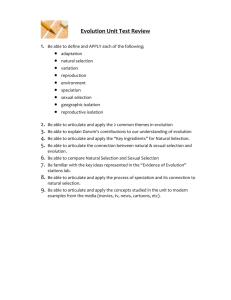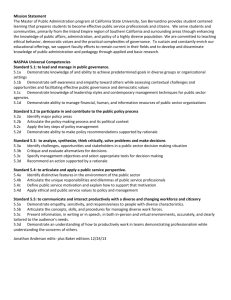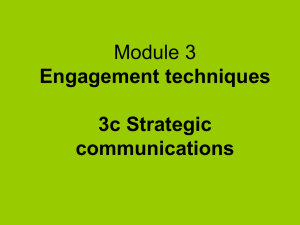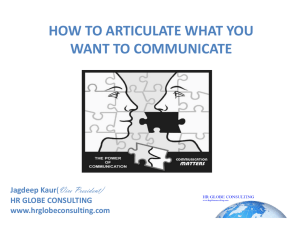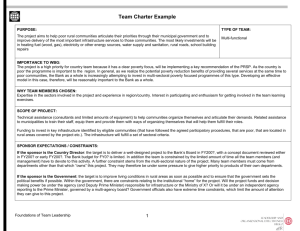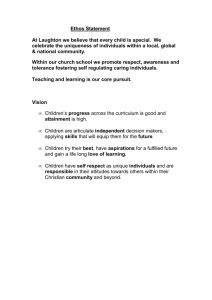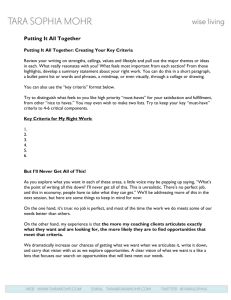Presentation Slides - National Rural Health Resource Center
advertisement
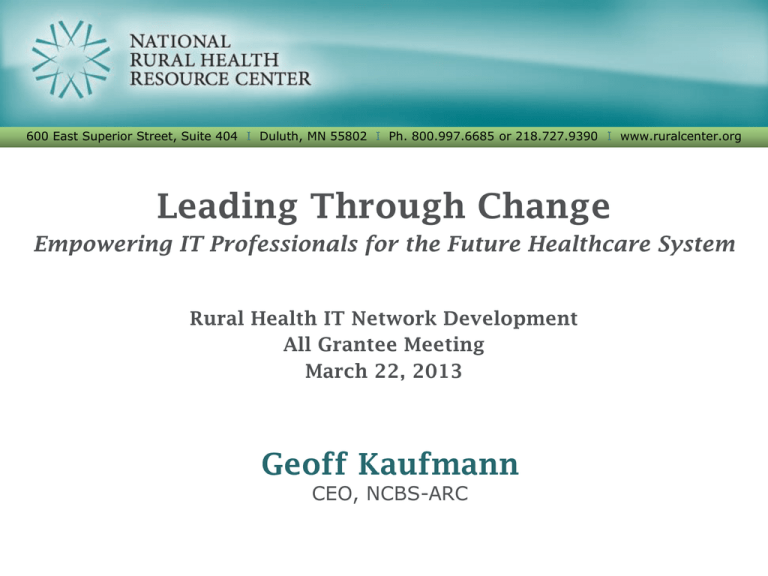
600 East Superior Street, Suite 404 I Duluth, MN 55802 I Ph. 800.997.6685 or 218.727.9390 I www.ruralcenter.org Leading Through Change Empowering IT Professionals for the Future Healthcare System Rural Health IT Network Development All Grantee Meeting March 22, 2013 Geoff Kaufmann CEO, NCBS-ARC Purpose The National Rural Health Resource Center is a nonprofit organization dedicated to sustaining and improving health care in rural communities. As the nation’s leading technical assistance and knowledge center in rural health, The Center focuses on five core areas: • Performance Improvement • Health Information Technology • Recruitment & Retention • Community Health Assessments • Networking You Just Won the Lottery People who handle change well are willing to take some risks and commit to decisions. • • Often we don’t take risks because we are so focused on the potential negative points that we forget about the positives. 3 Charles Darwin said: “It’s not the strongest species that survive, nor the most intelligent, but the ones most responsive to change.” 4 Learning Objectives • Describe what change looks and feels like. • Explain why change doesn’t happen. • Outline what you need to do to make change happen (reduce resistance, build resiliency, and enhance commitment). • Articulate change best practices and when they should happen. • Identify your individual opportunities in guiding change. 5 What is Effective Change Management? What We Hear vs. A Better Formula •On time •On budget •Technical objectives achieved •Road kill, collateral damage is minimal 6 •Astute strategic thinking and planning (external and internal analysis) •On time •On budget •Technical objectives achieved •Positive human objectives met (engaged & committed) •Enhanced organizational and human capacity Risks of Not Enabling Change Desired changes are not realized. Change occurs only after great expense. CHANGE 7 Future change efforts are compromised. No Decision • The “Black Hole” of change is the maintenance of the status quo • Without an inherent dissatisfaction with the way things are there is no urgency and no change • Moving away from pain (change) is a bigger motivator than moving towards gain • It must be about better and more “value” 8 Customer Status Quo Outcome at Risk( because of status quo gaps) Threats Problems Misses New Needs Redefined New Solution New End State 9 Productivity Productivity How does an average employee spend their eight hour work day? Guesses? Social Personal 10 Productivity How an average employee spends their eight hour work day. Productivity 5.8 Social 1.0 Personal 1.2 11 Productivity How does an employee spend their eight hours when dealing with organizational changes? Social/Gossip/Speculation “ME” How/What to Do? Productivity 12 Productivity How employees spend their eight hours when dealing with organizational changes. Social/Gossip/Speculation 1.8 “ME” 1.2 How/What to Do? 1.2 Productivity 3.8 13 $36,000 in Lost Productivity So if you have 10 people Making $40,000 annual salary Over a 3 month change process You lose 2 hours of productivity each 14 What Does Change Look & Feel Like? 15 Positive Response to Change Uninformed Optimism 16 Informed Pessimism Hopeful Realism Informed Optimism Transformational Change 17 Individual Perspective Exploring Zone Ending Beginning Optimism Shock Anger Acceptance Denial Testing Fear Uncertainty Sadness Confusion/ Doubt 18 The Change Gap Decision-Makers (Board of Directors, Executive Committee, CEO, Senior Management) IT professionals need to move towards earlier understanding Front Line Time 19 Resistance It doesn’t matter whether the change is perceived as positive or negative, resistance to major change is inevitable. Walls were meant to go over, around, through or under! 20 The Resistance Pyramid Not Able Not Willing Not Knowing 21 •Not Able: Lack of skills to execute the change. •Not Willing: Lack of motivation to enact the change. •Not Knowing: Lack of understanding or knowledge regarding the change. Communication around Change • Spray & Pray – shower employees with information hoping they will be able to sort out what is important • Tell & Sell – tell employees about the key issues then sell them on the wisdom of their approach • Underscore & Explore – develop a few core messages while actively listening for potential misunderstanding and unrecognized obstacles • Identify & Reply – identify key employee concerns and then reply to them • Withhold & Uphold – withhold information until necessary, control is the name of the game 22 How to Underscore & Explore • Translate objectives and priorities- In ways that are understandable • Repetition and redundancy- Using all forms of communication • Select the right channels- at all levels of the organization • Provoke dialogue - You can’t wait to talk to people until the strategy is in place. You need their input on implementation issues. Without understanding the general course of strategy, employees can’t contribute to an effective strategy implementation. • Check the pulse – Two-way communication, lack of feedback is selfdestructive 23 The Communication Channel Continuum Please review the list and prioritize with 1 being the most effective and 15 being the least effective 1 2 3 4 5 6 7 8 9 10 11 12 13 14 15 24 One-on-one/face-to-face communication Hallway/coffeepot communications Telephone conversation Text messages/Instant Messaging Voice Mail Small group meetings E-mail Video conferencing Conference calls Handwritten personal notes Advanced copies of agendas Inter-office memos Letters Formal speeches Large group meetings Why Changes Aren’t Implemented Quotes from the Field • “The energy required to evoke change inside the organization or to change the course is inadequate to surmount the resistance to change or the status quo.” • “The compelling case for change is just another millstone around the necks of the already overburdened staff who see it only as more work.” 25 Managing During Change (The World Does Not Stop) •Develop a clear business case and message for the change •Articulate vision and priorities •Design and implement a change plan Sustaining Exploring Implementing Creating Future State Change Management: The process that supports organizational and personal transitions from the current state to the desired future state. Current State Exploring Ending •Implement a two-way communication strategy •Involve people and build stakeholder commitment •Establish conditions for success - align culture, structure, process, etc. •Develop leadership, team and individual capacity to model the change •Monitor, learn, and course correct measurement systems 26 1. Develop a Clear Business Case and Message for the Change • Say why the organization must change - be concise, comprehensive, compelling, and support with evidence • Voice the positive and negative aspects of the change • Spell out the cost of not changing • Make it meaningful at every level • Develop a sense of urgency Sustaining 27 2. Articulate Vision, Strategy and Priorities for the Future • The vision provides the guiding light, an ideal picture of what the organization and the employees can become - the destination • The strategy is a stretch goal that people can identify with and not be overwhelmed by • The strategy should be reasonable given the organization’s culture and capacity • Strategy development and clarification should be completed with input from more than the board • Priorities should be clearly scripted in black and white terms •Spell out results to set clear mile markers 28 The Stability Mindset What do you think of the driver? 29 Past, Present and Future 1. Know where you have been 2. Know where you are now and how you got there 3. Articulate where you are going 4. Define how you will get there 5. Enable the change Seems easy right? Not so much! 30 Clear Results Spell out the cost for not changing Current Results Desired Results Labor costs exceeding budget Labor costs held to the budgeted level Following other states’ examples Leading other states No new products or services in the past 12 months At least one new product or service this year Missing schedule Meeting schedule Turnover 20% Turnover 10% Identify how we can make money from customers 31 Articulate for what value are customers truly willing to pay 3. Design and Implement a Change Plan • • • Complete a Change Assessment -Leadership – commitment & capacity -Culture – consistency with strategic direction -Individual and Team Capacity – behaviors to support the process Develop measures- track progress, short and long-term Review past implementation history -Find the bright spots where you can learn from what is working -Identify best practices 32 Change Readiness Assessment • How successful was your last change effort? • What worked and what didn’t work? • What is your current capacity to deal with more change? • How committed are your stakeholders? 33 4. Implement a Two-Way Communication Strategy • Discuss the results of your change readiness assessment • Clarify expectations and measures • Ensure that someone is responsible for developing and implementing a communication plan • Repeat your message several times using different communication methods • Engage people at all levels of the organization in dialogue around proposed changes • Set up listening posts to ensure understanding 34 Keep It Safe • When it is safe, you can say anything. • Recognize the cues that you are moving out of a safe zone. • Nothing kills the flow of dialogue like fear – fight or flight. • Watch for others’ indication that they don’t feel safe – silence or violence. 35 How to Establish Safety • Mutual Purpose • Mutual Respect • Apologize When Appropriate • Contrast to Fix Understanding 36 Mutual Purpose • Others perceive that we are working toward a common outcome, that we care about their goals, interests, and values. • Do others believe I care about their goals? • Do they trust my motives? • When at risk, we end up debating, trying to win, becoming silent • This is not a technique – you really have to care! 37 Mutual Respect How do you respect people you don’t respect: • Dialogue would be doomed if we had to respect every element of another person’s character. • Look for ways we are similar rather than looking for the differences. • “Help me forgive those who sin differently than I.” We all have weaknesses. 38 5. Involve People and Build Stakeholder Commitment • • • • • • • • • 39 Identify sponsors Select a transition team & provide them with a change training Eliminate those who don’t or won’t fit into the new plan Find what motivates people Involve employees in design and decision making Ask employees to identify obstacles whenever they find them and propose solutions to remove them Confront blockers & saboteurs, make them part of the solution when possible Create steering committees, task forces Release power and information for implementation to those involved Sponsorship •Power •Persistence •Perspective •Presence •Patience 40 6. Establish Conditions For Success • Implement temporary policies and procedure • Deal with the politics and build connections • Align strategy to culture, performance measures, structure and • • • • • 41 process, and people Identify activities that can be eliminated or temporarily postponed Develop a project plan that establishes “mile markers”, short term successes that can be measured and celebrated Celebrate success along the way– create a variety of reward and recognition methods Tweak the environment to enable the change Shrink the change to something manageable Start/Stop Analysis Start (We will start...) Stop (We will stop...) Continue (We will continue....) •Fostering Process/ Structure Changes People Changes Performance Measurement Changes Culture Changes 42 •Collaborating across all product categories •Knowing how to work with other depts./areas to coordinate discounts and promotions •Creating marketing campaigns without approval •Hiring problem solvers •Using the best person for the job •Confronting poor performance and providing feedback •Blaming •Measuring •Changing employee satisfaction •Rewarding initiative •Communicating and measuring specific/written expectations initiative to figure out what needs to be done differently others •Managing everyone the same •Not accepting personal responsibility targets when obstacles present themselves •Being sporadic in goal measurements and expectations •Taking •Waiting to be told what to do a strong work ethic and pride in the company •Encouraging employees to grow as individuals in order to help the company grow. •An “open door” policy around discussing strategies and changes •Setting goals •Recognizing achievement (and progress) •Sharing goals with everyone •Publicly recognizing achievers •Helping others reach goals •“Doubling down” when it gets tough •Fostering a strong work ethic and pride in the organization “Building a visionary company requires 1% vision and 99% alignment.” Jim Collins author of Build to Last 43 What will the “Fab Four” look like when we get there? • Culture – values, norms, how people act • People – competencies, skills, ability, aptitude, diversity • Organizational structure and processes – roles, jobs, workflow, budgets, policy, exceptions, communications, facilities, etc. • Performance Measures – financial, human, operational, stakeholders, etc. Answers “How will we know when we get there?” 45 Culture •The challenge is to change an ingrained culture in response to a changed strategy – old culture almost always wins if not managed properly. •If an organization begins to fail it implies that elements of the culture have become dysfunctional and must change. •Culture change, then, is an inevitable corollary to strategic change – both difficult to manage if not understood. 46 7. Develop Leadership, Team and Individual Capacity • Grow your people by providing ongoing development -cross training -professional associations • Provide the knowledge, skills and abilities to implement the change • Build habits by reinforcing desired behavior • Walk the talk to demonstrate expectations 47 Leadership Strategy and leadership are interdependent. If you don’t have a strategy, you can’t lead; and a strategy without leadership gets you nowhere. It takes strong leaders to generate great insights, make hard choices, create a clear focus, align their organization, inspire their people, and lead change. Leaders are effective project and people managers. They maximize their ROPP – return on people and process – to bring the best out of what you have. 48 Seven Essential Leadership Behaviors You must have the courage to: • Know your people and your business • Insist on realism • Set clear goals and priorities • Follow through – walk the talk • Reward the doers • Expand people’s capabilities • Know yourself 49 Are You Strategy Averse? • Can you easily recite the top three strategic objectives of your organization? Your division? • Can your team describe specifically in 90 seconds how they are contributing to those objectives? • Do you have vigorous debates in meetings, not about egos or personalities, but about what is best for the business? • Are you willing to see your job changed or eliminated? • Do you have support of key people? • Are you open to getting help from the outside? • Do you see the need to plan ahead? • Do you believe the statement “pay now or pay later”? 50 8. Monitor, Learn, and Course Correct • Establish listening posts to identify where things aren’t • • • • • 51 working as planned Reallocate resources Develop a process for dealing with and deciding how to use feedback and data Develop a process for communicating the impact of feedback and data, what was used, and how it was used Answer the questions “What’s working, what’s not working?” at each phase of the process Document best practices Responsibility Integrity culminates in the ability to take full, effective responsibility. The ordinary definition of responsibility: Whose fault is this? The successful person’s definition: What can I learn from this? What needs to be done? 52 Responsibility • See it • Own it • Solve it • Do it 53 “In the end, it is important to remember that we cannot become what we need to be by remaining what we are. It’s a fact that when you’re through changing, you’re through.” Max Depree 54 Questions?
